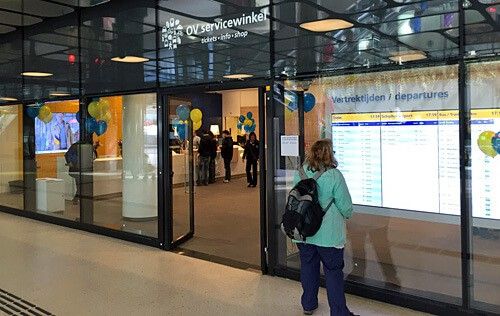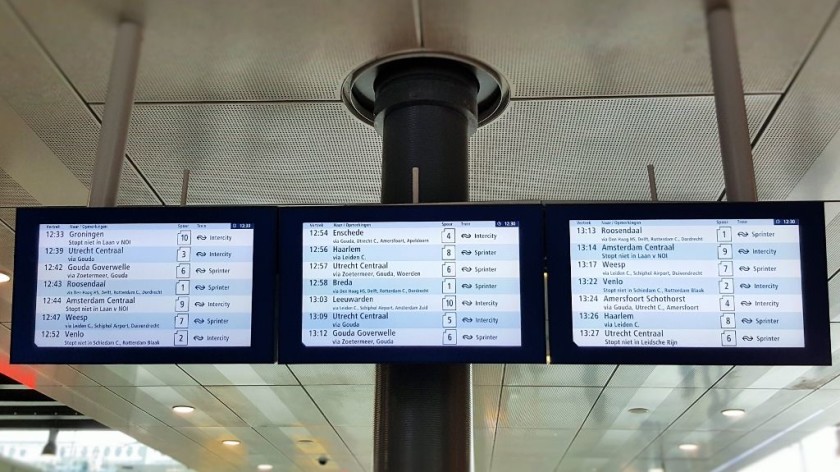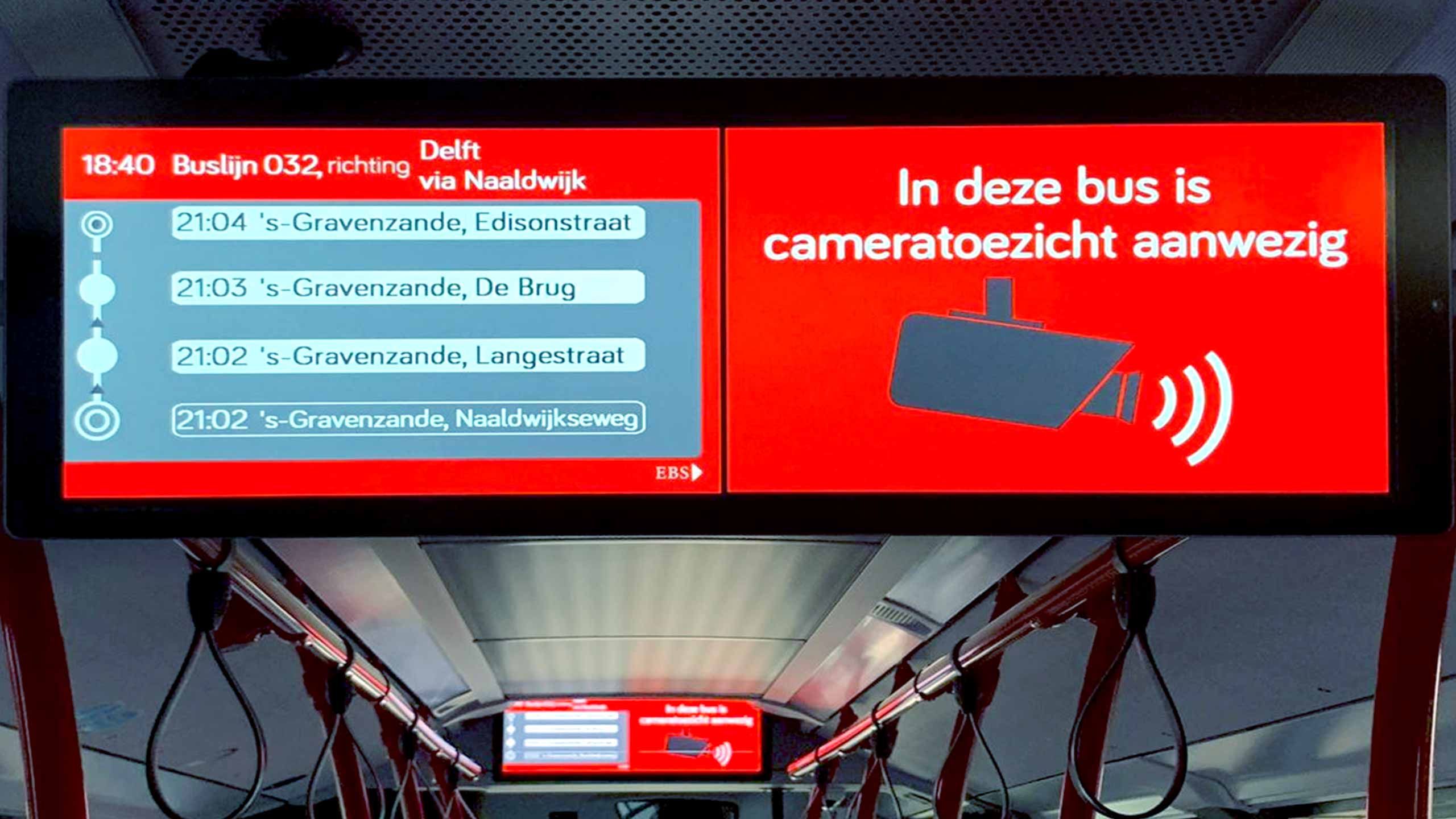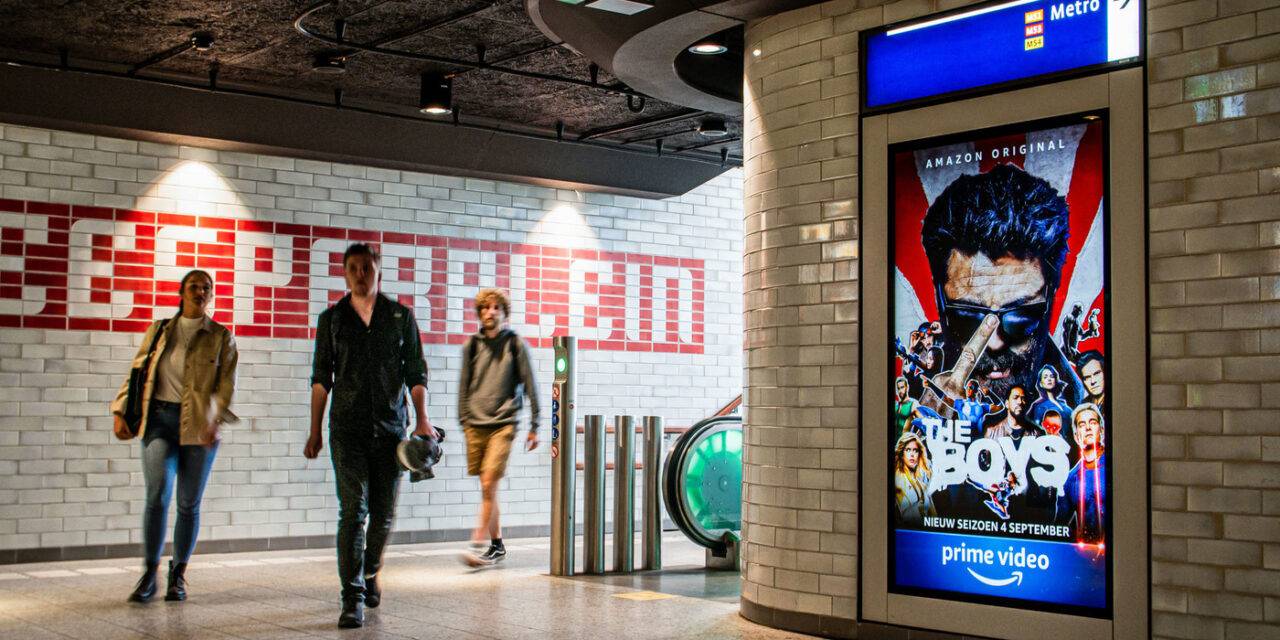
Transportation digital signage is an invaluable asset that can tailor content to suit the diverse needs of every audience. It is revolutionising public transit infrastructure. With a staggering 90% of information processed by the brain being visual, the integration of digital signage technology in buses, trams and train stations significantly boosts the retention of pertinent information. This article delves into the transformative impact of this technology on public transport systems.
Keep reading to find out more about:
- What Digital Signage Is and How It Can Be Used in Public Transport
- 5 Benefits of Using Digital Screens in Public Transport
- Best Practices for Digital Signage Content in Public Transportation
- Interactive Digital Signage in Public Transport
- Real-World Success Story: The Dutch Public Transit Systems
Introduction to Digital Signage in Public Transit
Let’s begin with an imagination exercise. Picture your local central train station. How easy is it to find your way around it? Are there any screens around announcing the day’s departures and arrivals? If your answer is yes to most questions, then you are likely to be living in a smart city – a place that has been digitised to make it easier for its residents to find useful information.
Digital signage plays an important role in modern public transportation systems, transforming how information is conveyed to commuters and improving their overall travel experience. This technology comprises electronic displays that show advertising, entertainment and real-time information, becoming an integral part of bus and metro stations, as well as airports around the world.
5 Benefits of Using Digital Screens in Public Transport
1. Streamlining Information Delivery
One of the most direct benefits of digital signage for commuters is the streamlined dissemination of crucial travel information through passenger information systems that provide real-time data, simplifying the travel experience. Real-time updates on arrival and departure times, delays and cancellations are instantly displayed, allowing passengers to make informed decisions about their travel plans. This real-time communication reduces the uncertainty and anxiety associated with public transport, making the commuting experience more predictable and stress-free.
2. Enhancing Safety and Security
Moreover, digital signage is instrumental in bolstering the safety and security of public transportation settings. It enables the rapid circulation of safety updates and emergency information on digital displays, offering guidance to commuters during unforeseen situations or emergencies by providing clear and actionable information. By displaying evacuation routes and safety rules, digital signage contributes to maintaining order and tranquillity, ensuring passengers of their safety within the public transport network.
3. Promoting Sustainable Travel Behaviours
Furthermore, digital signage can nudge commuters towards sustainable travel behaviours by showcasing target content that promotes eco-friendly travel choices, fostering a culture of environmental consciousness in transit. Provide information on the environmental benefits of public transportation, promote off-peak travel to reduce congestion and even suggest active transport connections. Participating in green living initiatives, like bike-sharing schemes, not only educates passengers but also fosters community engagement, building a community committed to eco-friendly travel choices.
4. Improving Accessibility
Digital signage enhances the accessibility of public transport by catering to diverse commuter needs. Displays that include high-contrast visuals, large text and clear icons benefit passengers with visual impairments, while real-time captions and sign language videos can assist those with hearing difficulties. By making information more accessible, this technology ensures that public transport is inclusive for all community members.
5. Facilitating Targeted and Interactive Communication
Modern digital signage solutions offer interactive capabilities, enabling commuters to engage with the content directly. Touchscreen displays can provide personalised travel information, wayfinding assistance and even entertainment options, making waiting times more bearable and engaging. This interactive element not only enriches the commuter experience but also fosters a sense of connection with the public transport system.
Best Practices for Digital Signage Content in Public Transportation
Creating content for digital signage in public transit systems means crafting a message that speaks directly to each passenger, guiding, informing and enhancing their journey. To make sure this message is clear and effective, there are some key practices you should follow. These tips will help make the digital signs in buses, trains and stations more than just screens, but valuable tools for everyone using them.
Keep It Simple and Clear
The most important thing to remember is to keep your message straightforward. Use simple language that everyone can understand. Think of it as if giving directions to a friend visiting the city for the first time. You would not use complicated jargon or long sentences, right? Apply the same principle here. Short, clear messages ensure that passengers can quickly glance at the screen and get the information they need without confusion.
Use Visuals Wisely
A picture is truly worth a thousand words, especially when it comes to digital signage. Using visuals like maps, icons and symbols can convey a lot of information quickly and transcend language barriers. But it is crucial to use them wisely. Make sure any visuals are easy to understand and large enough to be seen from a distance. This is especially helpful in busy transit environments where people might only have a few moments to look at the screen.
Update Content Regularly
Public transportation is always on the move and so should your content. Regular updates are crucial, especially for real-time information like schedules, delays or service changes. Still it is not just about the essential info; refreshing the content keeps it interesting for regular commuters and can be used to highlight new services, promotions or safety campaigns.
Consider the Time and Place
Timing and location are everything. The content displayed should be relevant to the time of day and the specific location of the signage. For example, morning commuters might benefit from traffic updates and weather forecasts, while evening passengers might appreciate information about local events or services. Similarly, placing screens near exits could provide wayfinding information, helping people navigate their way out or to their next mode of transport.
Prioritise Accessibility
Making digital signage accessible to everyone is not just good practice; it is essential. This means using high-contrast colours for better visibility, including audio descriptions for the visually impaired and ensuring that text size is large enough to be read from afar. Remember, public transportation serves a diverse community and digital signs should cater to the needs of all passengers.
Interactive Digital Signage in Public Transport
Interactive digital signage in public transport is like having a smart assistant ready to help you navigate your journey. It is an innovative way to communicate with passengers, offering more than just static information. This type of signage invites travellers to engage directly with the content, making their experience more personalised and informative.
Let’s dive into how making this technology interactive is transforming public transportation and making trips smoother and more enjoyable for everyone.
Making Information Personal
One of the biggest advantages of interactive digital signage is its ability to tailor information to individual needs. Passengers can input their destination and receive customised route options, estimated arrival times and even suggestions for nearby attractions or amenities. This personal touch not only improves the travel experience but also empowers passengers to make informed decisions about their journey.
Enhancing Accessibility
Interactive signage goes a long way in making public transport more accessible to everyone. Touchscreens with adjustable text size and audio feedback options ensure that information is reachable to passengers with visual or hearing impairments. Moreover, user-friendly interfaces can assist travellers who may not be familiar with the local language, breaking down barriers and fostering a more inclusive environment.
Streamlining Ticketing Processes
Gone are the days of standing in long lines to buy or validate tickets. Interactive digital signage can double as ticketing kiosks, allowing passengers to purchase or scan tickets with ease. This not only speeds up the boarding process but also reduces the need for physical ticket counters, saving space and resources.
Providing Real-Time Updates
Interactive signage excels in delivering real-time updates directly to passengers. From sudden schedule changes to unexpected delays, this dynamic platform ensures that travellers are always in the loop. By integrating with live data feeds, the displays can update their content automatically, providing the most current information at the touch of a screen.
Offering Wayfinding Solutions
Navigating large transit hubs can be daunting, especially for first-time visitors or those with mobility challenges. Integrating interactivity can offer detailed maps and wayfinding solutions, guiding passengers through complex stations with step-by-step directions. This can significantly reduce anxiety and improve the overall efficiency of the transport system.
Engaging with Feedback and Surveys
Another unique feature of interactive digital signage is its ability to collect passenger feedback. Transit authorities can use this feature to conduct surveys, gather suggestions or even report issues. This direct line of communication between passengers and service providers fosters a sense of community and can lead to meaningful improvements in the public transport experience.
Real-life Success Story: Enhancing the Public Transit Experience in the Netherlands

When done right, digital signage can truly make a difference for public transit passengers. Let us take the Dutch public infrastructure as a success story example. Modernised with digital screens in every bus, train, tram and metro, the experience of finding one’s way around in this country is seamless and pleasant for tourists and regular commuters alike.
Every central train station, regardless of the location, is equipped with advanced digital signage systems that display real-time information about departures and arrivals, as shown in the picture below.

Moreover, as travellers step into their chosen means of transportation, they are greeted by displays that help make their journey easier. The screen in the image below has been split into two smaller ones: one that shows the estimated arrival time for each stop and one that gives useful information. In this case, the announcement indicates that the bus has been equipped with cameras, which will help ease the anxiety that many passengers face regarding petty theft in public transport.
Notice the choice of high-contrasting colours. As said before, making sure the content on the screens is accessible to everyone is crucial. Not only does the red stand out against the white text, but the camera symbol is universal so even a non-Dutch speaker could understand the bus is using surveillance.

Finally, once they step out, digital signs are used to advertise relevant information and services. These signs promote nearby leisure activities or even suggest the next TV series to watch during the commute.

Thus, the Netherlands public transit authorities make strategic and varied use of screens, making sure those who choose to use public transport can do it in the most efficient and stress-free way possible.
Conclusion
Today’s article explored the role of digital signage in public transportation. From offering real-time updates and interactive services to improving safety and accessibility, this technology is transforming how transit authorities communicate with passengers and manage their services.
As public transport continues to evolve, its role in shaping the future of urban mobility cannot be underestimated. It stands as a testament to how technology can improve the collective travel experience, making public transportation a more attractive option for everyone. By embracing these digital solutions, transit authorities can not only meet the growing demands of modern commuters but also contribute to the development of smarter, more sustainable cities.
In conclusion, digital signage in public transportation is not just enhancing the infrastructure; it is transforming the very essence of how we move through our cities. As we look forward to the future of public transport, continuous innovation will undoubtedly play an important part in making our journeys more connected, informative and enjoyable for all.
(March 11, 2024). Andreea – MagicInfo Service. Retrieved from https://blog.magicinfoservices.com/blog/digital-signage-public-transport-enhancement

.jpg?width=702&height=386&name=Best%20Practices%20for%20Creating%20Digital%20Signage%20Content%20(1).jpg)
